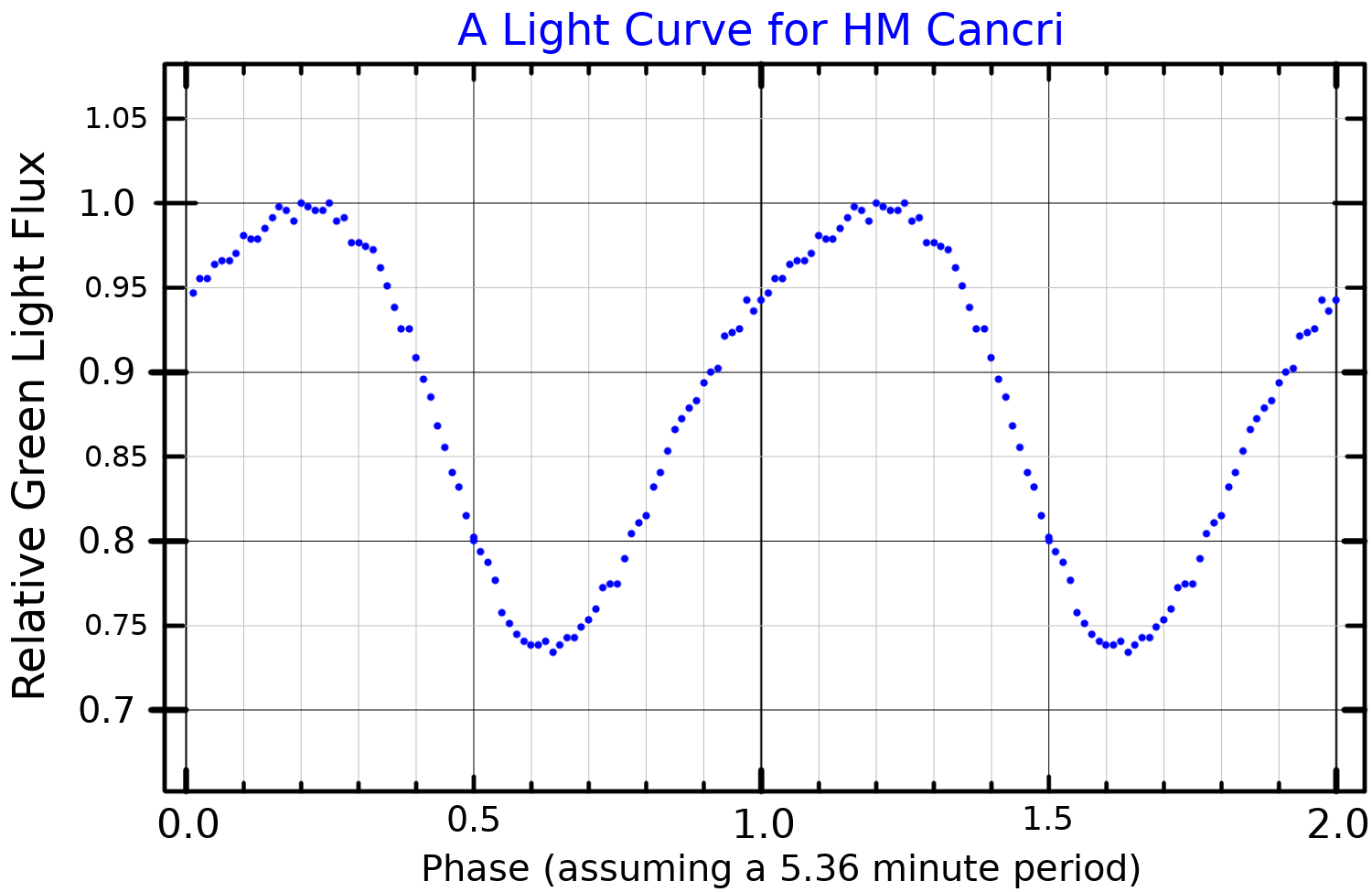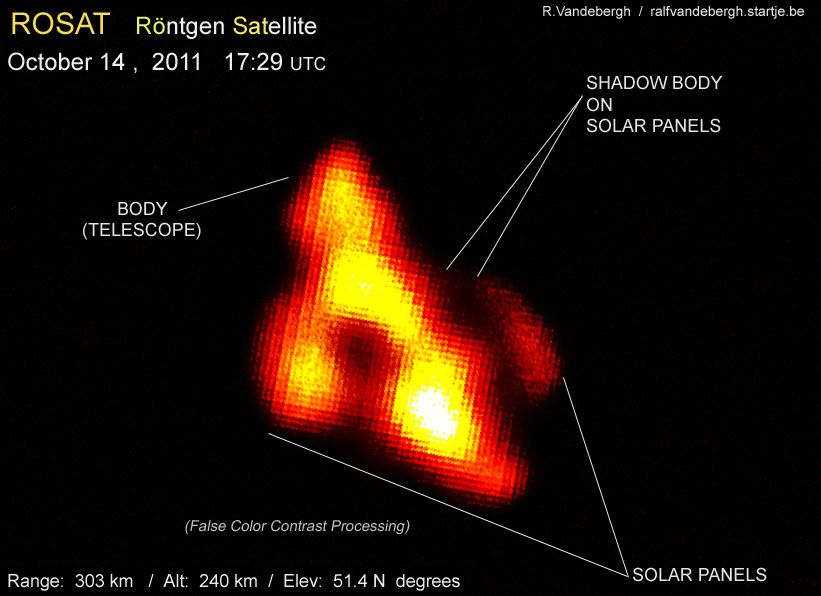|
HM Cancri
, - style="vertical-align: top;" , Distance , 1,600 Light-years , - ! style="background-color: #FFFFC0;" colspan="2" , Binary orbit , - style="vertical-align: top;" , Period (P) , 321.5 seconds , - style="vertical-align: top;" , dP/dt (Pdot) , 1.1 milliseconds per year , - style="vertical-align: top;" , Separation: , 0.0005 AU HM Cancri (also known as HM Cnc or RX J0806.3+1527) is an X-ray binary star system about away. It comprises two dense white dwarfs orbiting each other once every 5.4 minutes, at an estimated distance of only apart (about 1/5 the distance between the Earth and the Moon). The two stars orbit each other at speeds in excess of . The stars are estimated to be about half as massive as the Sun. Like typical white dwarfs, they are extremely dense, being composed of degenerate matter, and so have radii on the order of the Earth's radius. Astronomers believe that the two stars will eventually merge, based on data from many X-ray satellites, such a ... [...More Info...] [...Related Items...] OR: [Wikipedia] [Google] [Baidu] |
J0806 (binary Star - Artist's Conception)
, - style="vertical-align: top;" , Distance , 1,600 Light-years , - ! style="background-color: #FFFFC0;" colspan="2" , Binary orbit , - style="vertical-align: top;" , Period (P) , 321.5 seconds , - style="vertical-align: top;" , dP/dt (Pdot) , 1.1 milliseconds per year , - style="vertical-align: top;" , Separation: , 0.0005 AU HM Cancri (also known as HM Cnc or RX J0806.3+1527) is an X-ray binary star system about away. It comprises two dense white dwarfs orbiting each other once every 5.4 minutes, at an estimated distance of only apart (about 1/5 the distance between the Earth and the Moon). The two stars orbit each other at speeds in excess of . The stars are estimated to be about half as massive as the Sun. Like typical white dwarfs, they are extremely dense, being composed of degenerate matter, and so have radii on the order of the Earth's radius. Astronomers believe that the two stars will eventually merge, based on data from many X-ray satellites, such a ... [...More Info...] [...Related Items...] OR: [Wikipedia] [Google] [Baidu] |
ROSAT Objects
ROSAT (short for Röntgensatellit; in German X-rays are called Röntgenstrahlen, in honour of Wilhelm Röntgen) was a German Aerospace Center-led satellite X-ray telescope, with instruments built by West Germany, the United Kingdom and the United States. It was launched on 1 June 1990, on a Delta II rocket from Cape Canaveral, on what was initially designed as an 18-month mission, with provision for up to five years of operation. ROSAT operated for over eight years, finally shutting down on 12 February 1999. In February 2011, it was reported that the satellite was unlikely to burn up entirely while re-entering the Earth's atmosphere due to the large amount of ceramics and glass used in construction. Parts as heavy as could impact the surface. ROSAT eventually re-entered the Earth's atmosphere on 23 October 2011 over Bay of Bengal. Overview According to NASA, the Roentgensatellit (ROSAT) was a joint German, U.S. and British X-ray astrophysics project. ROSAT carried a Germ ... [...More Info...] [...Related Items...] OR: [Wikipedia] [Google] [Baidu] |
Objects With Variable Star Designations
Object may refer to: General meanings * Object (philosophy), a thing, being, or concept ** Object (abstract), an object which does not exist at any particular time or place ** Physical object, an identifiable collection of matter * Goal, an aim, target, or objective * Object (grammar), a sentence element, such as a direct object or an indirect object Science, technology, and mathematics Computing * 3D model, a representation of a physical object * Object (computer science), a language mechanism for binding data with methods that operate on that data ** Object-orientation, in which concepts are represented as objects *** Object-oriented programming (OOP), in which an object is an instance of a class or array ** Object (IBM i), the fundamental unit of data storage in the IBM i operating system * Object (image processing), a portion of an image interpreted as a unit * Object file, the output of a compiler or other translator program (also known as "object code") * Object, an ... [...More Info...] [...Related Items...] OR: [Wikipedia] [Google] [Baidu] |
Gravitational Waves
Gravitational waves are waves of the intensity of gravity generated by the accelerated masses of an orbital binary system that propagate as waves outward from their source at the speed of light. They were first proposed by Oliver Heaviside in 1893 and then later by Henri Poincaré in 1905 as waves similar to electromagnetic waves but the gravitational equivalent. Gravitational waves were later predicted in 1916 by Albert Einstein on the basis of his general theory of relativity as ripples in spacetime. Later he refused to accept gravitational waves. Gravitational waves transport energy as gravitational radiation, a form of radiant energy similar to electromagnetic radiation. Newton's law of universal gravitation, part of classical mechanics, does not provide for their existence, since that law is predicated on the assumption that physical interactions propagate instantaneously (at infinite speed)showing one of the ways the methods of Newtonian physics are unable to explain ph ... [...More Info...] [...Related Items...] OR: [Wikipedia] [Google] [Baidu] |
General Relativity
General relativity, also known as the general theory of relativity and Einstein's theory of gravity, is the geometric theory of gravitation published by Albert Einstein in 1915 and is the current description of gravitation in modern physics. General relativity generalizes special relativity and refines Newton's law of universal gravitation, providing a unified description of gravity as a geometric property of space and time or four-dimensional spacetime. In particular, the ' is directly related to the energy and momentum of whatever matter and radiation are present. The relation is specified by the Einstein field equations, a system of second order partial differential equations. Newton's law of universal gravitation, which describes classical gravity, can be seen as a prediction of general relativity for the almost flat spacetime geometry around stationary mass distributions. Some predictions of general relativity, however, are beyond Newton's law of universal gra ... [...More Info...] [...Related Items...] OR: [Wikipedia] [Google] [Baidu] |
Albert Einstein
Albert Einstein ( ; ; 14 March 1879 – 18 April 1955) was a German-born theoretical physicist, widely acknowledged to be one of the greatest and most influential physicists of all time. Einstein is best known for developing the theory of relativity, but he also made important contributions to the development of the theory of quantum mechanics. Relativity and quantum mechanics are the two pillars of modern physics. His mass–energy equivalence formula , which arises from relativity theory, has been dubbed "the world's most famous equation". His work is also known for its influence on the philosophy of science. He received the 1921 Nobel Prize in Physics "for his services to theoretical physics, and especially for his discovery of the law of the photoelectric effect", a pivotal step in the development of quantum theory. His intellectual achievements and originality resulted in "Einstein" becoming synonymous with "genius". In 1905, a year sometimes described as his ' ... [...More Info...] [...Related Items...] OR: [Wikipedia] [Google] [Baidu] |
Magnitude (astronomy)
In astronomy, magnitude is a unitless measure of the brightness of an object in a defined passband, often in the visible or infrared spectrum, but sometimes across all wavelengths. An imprecise but systematic determination of the magnitude of objects was introduced in ancient times by Hipparchus. The scale is logarithmic and defined such that a magnitude 1 star is exactly 100 times brighter than a magnitude 6 star. Thus each step of one magnitude is \sqrt \approx 2.512 times brighter than the magnitude 1 higher. The brighter an object appears, the lower the value of its magnitude, with the brightest objects reaching negative values. Astronomers use two different definitions of magnitude: apparent magnitude and absolute magnitude. The ''apparent'' magnitude () is the brightness of an object as it appears in the night sky from Earth. Apparent magnitude depends on an object's intrinsic luminosity, its distance, and the extinction reducing its brightness. The ''absolute'' magni ... [...More Info...] [...Related Items...] OR: [Wikipedia] [Google] [Baidu] |
Nordic Optical Telescope
The Nordic Optical Telescope (NOT) is an astronomical telescope located at Roque de los Muchachos Observatory, La Palma in the Canary Islands. The telescope saw first light in 1988, and was officially inaugurated during September 1989. Regular observing started in 1990. It is funded by Denmark, Sweden, Norway, Finland, and (since 1997) Iceland. Access is provided directly to astronomers of the funding countries, and of all nationalities through international time allocation committees. The main mirror has a diameter of . The optical forming was done at the optical laboratory at the Tuorla Observatory, on mirror blanks made of Zerodur at Schott Glaswerke in Mainz, Germany. While the NOT was designed as a passive telescope, with the mirror sufficiently thick to keep its shape even without an active feedback loop, its mirror was designed to be suspended on a pneumatic support system. The designers had planned that this and the flexibility of the mirror would allow for the implem ... [...More Info...] [...Related Items...] OR: [Wikipedia] [Google] [Baidu] |
Telescopio Nazionale Galileo
The Galileo National Telescope, ( it, Telescopio Nazionale Galileo; TNG; code: Z19) is a 3.58-meter Italian telescope, located at the Roque de los Muchachos Observatory on the island of La Palma in the Canary Islands, Spain. The TNG is operated by the "Fundación Galileo Galilei, Fundación Canaria", a non-profit institution, on behalf of the Italian National Institute of Astrophysics (INAF). The telescope saw first light in 1998 and is named after the Italian Renaissance astronomer Galileo Galilei. Observations at the TNG can be proposed through the Italian Time Allocation Committee (TAC) which assigns, based on the scientific merit of the proposals, 75% of the available time. The rest of the time is at disposal of the Spanish and international astronomical communities. The TNG is open to new proposals two times a year, typically in March–April and September–October. Technical characteristics The TNG is an altazimuthal reflecting telescope with a Ritchey-Chretien optica ... [...More Info...] [...Related Items...] OR: [Wikipedia] [Google] [Baidu] |
Very Large Telescope
The Very Large Telescope (VLT) is a telescope facility operated by the European Southern Observatory on Cerro Paranal in the Atacama Desert of northern Chile. It consists of four individual telescopes, each with a primary mirror 8.2 m across, which are generally used separately but can be used together to achieve very high angular resolution. The four separate optical telescopes are known as ''Antu'', ''Kueyen'', ''Melipal'', and ''Yepun'', which are all words for astronomical objects in the Mapuche language. The telescopes form an array complemented by four movable Auxiliary Telescopes (ATs) of 1.8 m aperture. The VLT operates at visible and infrared wavelengths. Each individual telescope can detect objects roughly four billion times fainter than can be detected with the naked eye, and when all the telescopes are combined, the facility can achieve an angular resolution of about 0.002 arcsecond. In single telescope mode of operation angular resolution is about 0.05 ar ... [...More Info...] [...Related Items...] OR: [Wikipedia] [Google] [Baidu] |
ROSAT
ROSAT (short for Röntgensatellit; in German X-rays are called Röntgenstrahlen, in honour of Wilhelm Röntgen) was a German Aerospace Center-led satellite X-ray telescope, with instruments built by West Germany, the United Kingdom and the United States. It was launched on 1 June 1990, on a Delta II rocket from Cape Canaveral, on what was initially designed as an 18-month mission, with provision for up to five years of operation. ROSAT operated for over eight years, finally shutting down on 12 February 1999. In February 2011, it was reported that the satellite was unlikely to burn up entirely while re-entering the Earth's atmosphere due to the large amount of ceramics and glass used in construction. Parts as heavy as could impact the surface. ROSAT eventually re-entered the Earth's atmosphere on 23 October 2011 over Bay of Bengal. Overview According to NASA, the Roentgensatellit (ROSAT) was a joint German, U.S. and British X-ray astrophysics project. ROSAT carried a Germa ... [...More Info...] [...Related Items...] OR: [Wikipedia] [Google] [Baidu] |



.jpg)
.jpg)
